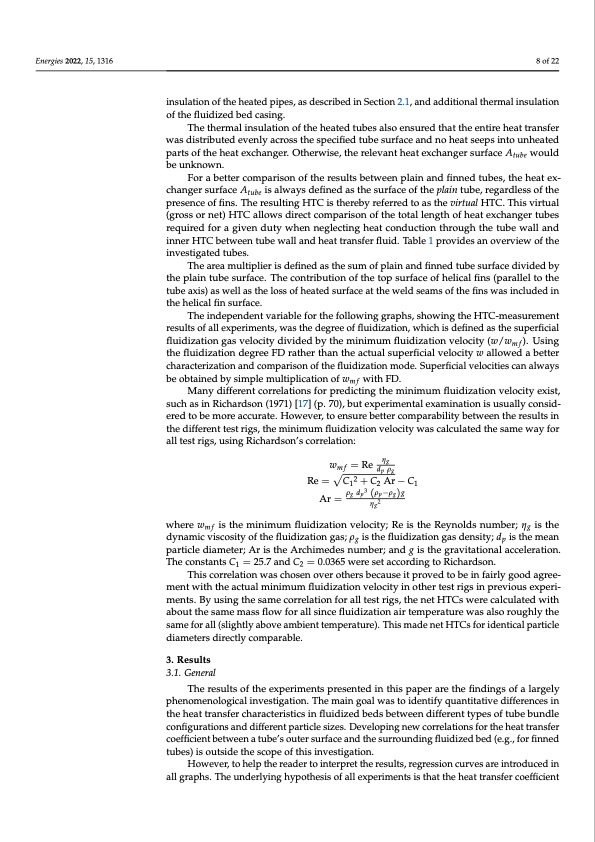
PDF Publication Title:
Text from PDF Page: 008
Energies 2022, 15, 1316 8 of 22 insulation of the heated pipes, as described in Section 2.1, and additional thermal insulation of the fluidized bed casing. The thermal insulation of the heated tubes also ensured that the entire heat transfer was distributed evenly across the specified tube surface and no heat seeps into unheated parts of the heat exchanger. Otherwise, the relevant heat exchanger surface Atube would be unknown. For a better comparison of the results between plain and finned tubes, the heat ex- changer surface Atube is always defined as the surface of the plain tube, regardless of the presence of fins. The resulting HTC is thereby referred to as the virtual HTC. This virtual (gross or net) HTC allows direct comparison of the total length of heat exchanger tubes required for a given duty when neglecting heat conduction through the tube wall and inner HTC between tube wall and heat transfer fluid. Table 1 provides an overview of the investigated tubes. The area multiplier is defined as the sum of plain and finned tube surface divided by the plain tube surface. The contribution of the top surface of helical fins (parallel to the tube axis) as well as the loss of heated surface at the weld seams of the fins was included in the helical fin surface. The independent variable for the following graphs, showing the HTC-measurement results of all experiments, was the degree of fluidization, which is defined as the superficial fluidization gas velocity divided by the minimum fluidization velocity (w/wm f ). Using the fluidization degree FD rather than the actual superficial velocity w allowed a better characterization and comparison of the fluidization mode. Superficial velocities can always beobtainedbysimplemultiplicationofwmf withFD. Many different correlations for predicting the minimum fluidization velocity exist, such as in Richardson (1971) [17] (p. 70), but experimental examination is usually consid- ered to be more accurate. However, to ensure better comparability between the results in the different test rigs, the minimum fluidization velocity was calculated the same way for all test rigs, using Richardson’s correlation: wmf =Re ηg dp ρg Re = C12 + C2 Ar − C1 Ar = ρg dp3 (ρp−ρg)g ηg2 where wm f is the minimum fluidization velocity; Re is the Reynolds number; ηg is the dynamic viscosity of the fluidization gas; ρg is the fluidization gas density; dp is the mean particle diameter; Ar is the Archimedes number; and g is the gravitational acceleration. The constants C1 = 25.7 and C2 = 0.0365 were set according to Richardson. This correlation was chosen over others because it proved to be in fairly good agree- ment with the actual minimum fluidization velocity in other test rigs in previous experi- ments. By using the same correlation for all test rigs, the net HTCs were calculated with about the same mass flow for all since fluidization air temperature was also roughly the same for all (slightly above ambient temperature). This made net HTCs for identical particle diameters directly comparable. 3. Results 3.1. General The results of the experiments presented in this paper are the findings of a largely phenomenological investigation. The main goal was to identify quantitative differences in the heat transfer characteristics in fluidized beds between different types of tube bundle configurations and different particle sizes. Developing new correlations for the heat transfer coefficient between a tube’s outer surface and the surrounding fluidized bed (e.g., for finned tubes) is outside the scope of this investigation. However, to help the reader to interpret the results, regression curves are introduced in all graphs. The underlying hypothesis of all experiments is that the heat transfer coefficientPDF Image | Heat Transfer between Finned Tubes

PDF Search Title:
Heat Transfer between Finned TubesOriginal File Name Searched:
energies-15-01316.pdfDIY PDF Search: Google It | Yahoo | Bing
Turbine and System Plans CAD CAM: Special for this month, any plans are $10,000 for complete Cad/Cam blueprints. License is for one build. Try before you buy a production license. More Info
Waste Heat Power Technology: Organic Rankine Cycle uses waste heat to make electricity, shaft horsepower and cooling. More Info
All Turbine and System Products: Infinity Turbine ORD systems, turbine generator sets, build plans and more to use your waste heat from 30C to 100C. More Info
CO2 Phase Change Demonstrator: CO2 goes supercritical at 30 C. This is a experimental platform which you can use to demonstrate phase change with low heat. Includes integration area for small CO2 turbine, static generator, and more. This can also be used for a GTL Gas to Liquids experimental platform. More Info
Introducing the Infinity Turbine Products Infinity Turbine develops and builds systems for making power from waste heat. It also is working on innovative strategies for storing, making, and deploying energy. More Info
Need Strategy? Use our Consulting and analyst services Infinity Turbine LLC is pleased to announce its consulting and analyst services. We have worked in the renewable energy industry as a researcher, developing sales and markets, along with may inventions and innovations. More Info
Made in USA with Global Energy Millennial Web Engine These pages were made with the Global Energy Web PDF Engine using Filemaker (Claris) software.
Sand Battery Sand and Paraffin for TES Thermo Energy Storage More Info
| CONTACT TEL: 608-238-6001 Email: greg@infinityturbine.com | RSS | AMP |